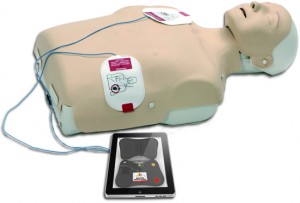 The iPad can't administer a lifesaving electrical jolt to the heart – yet – but a new app teaches people how to do so with the help of an automated external defibrillator (AED).
The iPad can't administer a lifesaving electrical jolt to the heart – yet – but a new app teaches people how to do so with the help of an automated external defibrillator (AED).
Croatian emergency physician Ivor Kovic and his company, Ivor Medical, recently released the AED Trainer app, which simulates operation of an actual AED, the portable device that allows medical professionals, emergency responders and laypeople alike to shock the heart back into rhythm in case of cardiac arrhythmia.
The app, available through iTunes at an introductory price of $5.99, walks users through the processes of attaching electrical pads to the right spots on a patient's chest, then, if necessary, delivering an electric shock from the machine to help restore normal heartbeat. The simulation mimics the display screen, buttons, sounds and voice prompts of a typical AED.
AED Trainer also allows instructors to generate custom training scenarios to help teach proper and appropriate AED usage, including how to administer CPR after delivering and electric shock. It is designed to work in concert with CPR mannequins and adhesive chest pads.
At press time, the product page on the Ivor Medical website was down, but the company has posted a video demonstration of AED Trainer here.
Kovic is a European champion of sorts for mobile technology in emergency care. Last year, he co-authored a paper in Resuscitation, the journal of the European Resuscitation Council, on the role of mobile phones in what he has dubbed the "chain of survival." According to Kovic, phones obviously can be used to call for help at the first sign of an emergency and for post-CPR communications, but smartphones in particular also can assist in educating and refreshing the memory of rescuers about lifesaving actions people on the scene should take.
"[Mobile phones] have a potential to allow for a faster and superior emergency medical services contact, assure a higher quality of cardiopulmonary resuscitation (CPR) and quicker retrieval of an automated external defibrillator and facilitate a finer post-resuscitation care through telemedical and clinical decision support systems," Kovic and a colleague wrote. "Smartphones, mobile phones with advanced computing abilities and connectivity, should be considered as medical devices, and their use, among lay rescuers and medical professionals in cardiovascular emergencies, further investigated and strongly encouraged," they added.
Kovic discusses the "chain of survival" here.
















